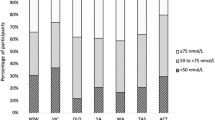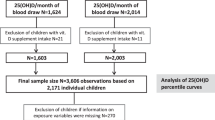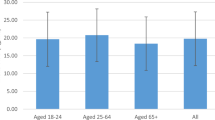Abstract
Objective: To describe the prevalence and determinants of 25-hydroxy D3(25(OH)D) in children.
Design: Cross-sectional study.
Setting: Southern Tasmania between June and November 1997.
Subjects: Two hundred and one 8-y old male and female children taking part in a cohort study whose principal endpoints were blood pressure and high-density lipoprotein (HDL) cholesterol.
Results: The mean 25(OH)D level was 79 nmol/l (s.d. 29.5, median 73, range 12–222). Boys had higher levels than girls (82.1 vs 72.8 nmol/l, P=0.02). 25(OH)D was associated with sunlight exposure in winter school holidays (r=0.20, P=0.005) and winter weekends (r=0.16, P=0.02), the month after school holidays (87.5 vs 69.5 nmol, P<0.0001) and body mass index (r=−0.23, P=0.001). Dietary intake of vitamin D was low (mean 40 IU/day, range 5.2–384) and was not associated with 25(OH)D levels (r=0.01, P=0.91). Variation in skin melanin density was weakly associated with 25(OH)D (r=0.09, P=0.19).
Conclusions: Sunlight is the major determinant of vitamin D stores in our population. Neither variation in skin type within Caucasians nor diet modified this association to any significant extent. Extrapolation of these findings to sunlight bone mass associations in a very similar population suggests that a minimum level of around 50 nmol/l in the population is required for optimal bone development in prepubertal children but this needs to be confirmed with further controlled trials of vitamin D supplementation and bone mass.
Sponsorship: Arthritis Foundation of Australia, Roche Pharmaceuticals.
This is a preview of subscription content, access via your institution
Access options
Subscribe to this journal
Receive 12 print issues and online access
$259.00 per year
only $21.58 per issue
Buy this article
- Purchase on Springer Link
- Instant access to full article PDF
Prices may be subject to local taxes which are calculated during checkout
Similar content being viewed by others
Author information
Authors and Affiliations
Contributions
G Jones, Senior Research fellow, is the guarantor, contribution—study conception, data analysis, overall manuscript composition; CL Blizzard, is the statistician, contribution—data analysis, manuscript review; MD Riley, is the nutritional epidemiologist, contribution—processing and reporting of dietary data, manuscript review; V Parameswaran, is the hospital scientist, contribution & processing and reporting of laboratory data, manuscript review. TM Greenway, is the director, contribution—study conception, mauscript review; and T Dwyer, is professor and head, contribution—study conception, manuscript review.
Corresponding author
Rights and permissions
About this article
Cite this article
Jones, G., Blizzard, C., Riley, M. et al. Vitamin D levels in prepubertal children in Southern Tasmania: prevalence and determinants. Eur J Clin Nutr 53, 824–829 (1999). https://doi.org/10.1038/sj.ejcn.1600858
Received:
Revised:
Accepted:
Published:
Issue Date:
DOI: https://doi.org/10.1038/sj.ejcn.1600858
Keywords
This article is cited by
-
Vitamin D and Bone Health in Childhood and Adolescence
Calcified Tissue International (2013)
-
Vitamin D status in critically ill children
Intensive Care Medicine (2012)
-
The association between non-melanoma skin cancer and osteoporotic fractures—a population-based record linkage study
Osteoporosis International (2007)
-
Vitamin D insufficiency in adolescent males in Southern Tasmania: prevalence, determinants, and relationship to bone turnover markers
Osteoporosis International (2005)



